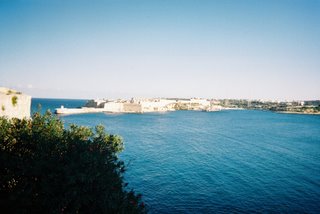Mid-Med Thanksgiving
 The Republic of Malta, located in the mid-Mediterannean, is south of Sicily and north of the north coast of Africa and consists of three inhabited islands: Malta, the largest (and site of the capital city of Valetta), Gozo and Comino. Nearly all the population lives on Malta, which is rocky, with few trees and no rivers (though there are natural springs). Malta has been the site of some of the oldest civilizations known to man. The photo shows a portion of the Grand Harbor of Valetta with some of the ancient fortifications visible.
The Republic of Malta, located in the mid-Mediterannean, is south of Sicily and north of the north coast of Africa and consists of three inhabited islands: Malta, the largest (and site of the capital city of Valetta), Gozo and Comino. Nearly all the population lives on Malta, which is rocky, with few trees and no rivers (though there are natural springs). Malta has been the site of some of the oldest civilizations known to man. The photo shows a portion of the Grand Harbor of Valetta with some of the ancient fortifications visible.Malta was conquered a number of times in its history. Perhaps the era for which it is historically most well-known is the time beginning in 1565 when the Knights of St. John of Jerusalem (also known as the Knights Hospitallers) defeated the previous Arab conquerors and made Malta a Christian country. The original purpose of the Knights was to care for pilgrims to the Holy Land who became ill on the journey. Over time their purpose began to change and the Knights became a brotherhood of warriors, though they still protected and treated pilgrims. (One of the major sites on Malta is the old (and now unused) hospital of the Knights, which boasts the longest hospital ward in the world.) For several centuries the Knights, who ruled the country, were unbeatable and their fortresses (which largely remain in place today) were impregnable.
In the early 19th century, Malta became a British crown colony and adopted English as a language, in addition to Malti, which has an Arabic base but is written in the Latin alphabet. Malta adopted a self-governing constitution in 1921, making the local government responsible for domestic affairs and leaving Britan in control of immigration and foreign policy. Malta probably made its most prominent entry on the world stage during World War II. With Sicily only a short distance to the north, the Italians being Allies of the Germans, and the German army under Rommel being in North Africa, Malta became a thorn in the side of German/Italian efforts to keep Rommel supplied by ship. The Axis forces tried to bomb the island into submission, making it, for a period of time, the most heavily bombed place on earth. But the island held out until the Royal Navy could get a convoy through (with heavy losses) and, when the British/American armies defeated Rommel in North Africa, the pressure on Malta abated.
Malta is an overtly Catholic country, with 98% of the population belonging to that faith and with over 400 churches for its population of about 400,000 people. The country has been deeply influenced by all the cultures that dominated the islands at various times and this is especially noteworthy in food and architecture. Many consider modern Malta to be an interesting combination of the "manana" culture and a vibrant work ethic.
We stayed at the modern and very comfortable Intercontinental hotel on St. George's bay, toured the very important Grand Harbor by boat, visited St. John's cathedral as well as the local Anglican "proto" cathedral (so-called because the real seat of the Anglican bishop is in Gibraltar) and St. Dominic's church. The latter, built only in 1952, replaced the church destroyed by German bombing during World War II; it is dominated by a huge oval shaped dome and is one of the most strikingly beautiful of the many, many churches we've visited in our many visits to European cities. We did most of our local getting around on regular city buses -- which are very cheap and convenient -- as well as being very interesting, since Malta appears to buy only used buses from other places and many have been restored and are kept in nearly pristine condition.
The island boasts a number of ruins from pre-historic cultures whose origins are unknown, but who built large stone temples, now in ruins. Interestingly, some of the ruins, which are impressive in scale, pre-date the pyramids of Egypt by as much as 1200 years! It is supposed that these ancient peoples came from Sicily (which is just visible on a clear day) rather than North Africa, which is never visible. Presumably these people wouldn't have set off on a voyage without any idea whether there was land "out there".
On our tours of the island we visited a couple of village open air markets and took a small boat ride into Malta's "Blue Grotto", with it's positively startling colors of blue water inside the caves -- no doubt a manifestation of some relatively uncommon aspect of the physics of light. Our travels also included a ferry ride to Gozo, the second island of Malta with only one real town of any size, but significantly greener than Malta itself.
Visit http://chuck.smugmug.com/gallery/2200370 to see some of our Malta photos.

0 Comments:
Post a Comment
<< Home